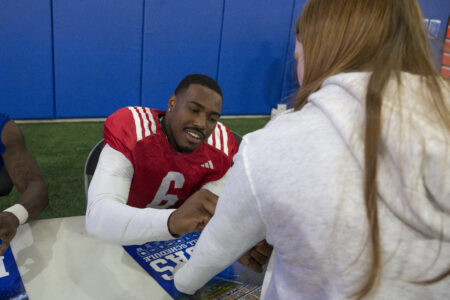KU defense drastically better on third downs
After watching film of his new team, Kansas University football defensive coordinator Dave Campo set out two main goals for his defensive players during their first meeting in the winter.
No. 1 was that the Jayhawks weren’t going to allow teams to run wild over them. And No. 2 was that KU was going to play better on third downs.
KU safety Bradley McDougald was happy to hear Campo talk about the third-down issue.
“That was one of our goals personally before we even had coaches,” McDougald said. “We knew we had to get off the field.”
The Jayhawks have been able to do that better so far this year, drastically improving their third-down defense from a season ago.
KU is ranked 37th nationally in third-down defense efficiency — a statistic coaches put up on a goal chart at the KU football facility. Opponents have converted 34 percent of their third downs.
Last year, the Jayhawks ranked 116th in the stat, allowing opponents to convert 51 percent of their tries.
“Third downs last year was a big downfall for us,” KU junior cornerback Tyler Patmon said, “because we’d come out strong, we’d stop them on first down, make a big play, then third down, we’d almost fall apart.
“I think that had something to do with having a new coach (defensive coordinator) at the end of spring and beginning of summer. Right now, I believe that we can get to third down and stop a lot of people on third down.”
Dig a little deeper, and numbers suggest that KU is an elite defense when an opponent has long distances to go.
The site FootballOutsiders.com has a defensive statistic that tracks how defenses perform on “passing downs,” which is plays that are second-and-eight or longer, third-and-five or longer and fourth-and-five or longer.
In that stat, KU is eighth nationally after ranking 104th a year ago.
“If you know they’re going to throw the football, that gives you an advantage,” Campo said. “I feel comfortable in those situations more than when it’s either-or.”
A defense has more options when a running play can be ruled out. Defensive linemen have less gap responsibility and can focus more on just getting upfield and to the quarterback. Campo also has more coverages available when he doesn’t have to worry about a potential run.
KU defensive backs coach Clint Bowen also believes that film study also has helped KU in those second- and third-and-longs.
“It’s not like an offense has 20 plays dialed up for third-and-10. There’s not enough time to practice them,” Bowen said. “You’re dealing with a handful of plays, so if your kids are in-tune to things, they’ve got a little bit better anticipation of what’s going to happen.”
Though KU has been able to thrive on third-and-longs, the problem has been getting opponents into that situation.
According to FootballOutsiders, KU’s ranks 101st nationally in standard downs, which consists of all the plays that aren’t passing downs.
“We’re trying to take steps in the right direction,” McDougald said.







